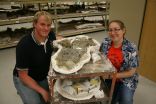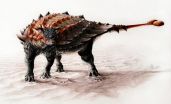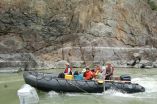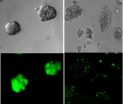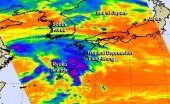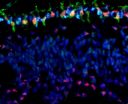New dinosaur from New Mexico has relatives in Alberta
2014-09-24
(Press-News.org) (Edmonton) A newly discovered armoured dinosaur from New Mexico has close ties to the dinosaurs of Alberta, say University of Alberta paleontologists involved in the research.
From 76 to 66 million years ago, Alberta was home to at least five species of ankylosaurid dinosaurs, the group that includes club-tailed giants like Ankylosaurus. But fewer ankylosaurids are known from the southern parts of North America. The new species, Ziapelta sanjuanensis, was discovered in 2011 in the Bisti/De-na-zin Wilderness area of New Mexico by a team from the New Mexico Museum of Natural History and Science and the State Museum of Pennsylvania.
The U of A researchers in the Faculty of Science, including recent PhD graduate Victoria Arbour and current doctoral student Michael Burns, were asked to be part of the project because of their expertise in the diversity of ankylosaurs from Alberta.
"Bob Sullivan, who discovered the specimen, showed us pictures, and we were really excited by both its familiarity and its distinctiveness—we were pretty sure right away we were dealing with a new species that was closely related to the ankylosaurs we find in Alberta," says Arbour.
Ziapelta is described in a new paper in PLOS ONE. It stands out from other ankylosaurs because of unusually tall spikes on the cervical half ring, a structure like a yoke of bone sitting over the neck. Ziapelta's skull also differentiates it from other known ankylosaurs.
"The horns on the back of the skull are thick and curve downwards, and the snout has a mixture of flat and bumpy scales—an unusual feature for an ankylosaurid," notes Arbour. "There's also a distinctive large triangular scale on the snout, where many other ankylosaurids have a hexagonal scale."
Ziapelta hails from the Late Cretaceous, when a vast inland sea divided North America in two, and Alberta and New Mexico each boasted beachfront property. Ankylosaur fossils are common in several of the rocky formations of Southern Alberta, but none have yet been found in the lower part of an area called the Horseshoe Canyon Formation—a gap in Alberta's ankylosaur fossil record.
"The rocks in New Mexico fill in this gap in time, and that's where Ziapelta occurs," says Arbour. "Could Ziapelta have lived in Alberta, in the gap where we haven't found any ankylosaur fossils yet? It's possible, but in recent years there has also been increasing evidence that the dinosaurs from the southern part of North America—New Mexico, Texas, and Utah, for example—are distinct from their northern neighbours in Alberta."
Arbour says Ziapelta may have belonged to this group of southern dinosaurs—but more fossils could be waiting to be unearthed in Alberta's Badlands. "We should be on the lookout for Ziapelta fossils in the Horseshoe Canyon Formation in the future."
INFORMATION:
ELSE PRESS RELEASES FROM THIS DATE:
A way to kill chemo-resistant ovarian cancer cells: Cut down its protector
2014-09-24
Ottawa, Canada – September 24, 2014 – Ovarian cancer is the most deadly gynecological cancer, claiming the lives of more than 50% of women who are diagnosed with the disease. A study involving Ottawa and Taiwan researchers, published today in the influential Proceedings of the National Academy of Sciences (PNAS), provides new insight into why ovarian cancer is often resistant to chemotherapy, as well as a potential way to improve its diagnosis and treatment.
It is estimated that 2,700 Canadian women will be diagnosed with ovarian cancer in 2014 and that 1,750 Canadian ...
Star Trekish, rafting scientists make bold discovery on Fraser River
2014-09-24
A Simon Fraser University-led team behind a new discovery has "…had the vision to go, like Star Trek, where no one has gone before: to a steep and violent bedrock canyon, with surprising results."
That comment comes from a reviewer about a truly groundbreaking study just published in the journal Nature.
Scientists studying river flow in bedrock canyons for the first time have discovered that previous conceptions of flow and incision in bedrock-rivers are wrong.
SFU geography professor Jeremy Venditti led the team of SFU, University of Ottawa and University of British ...
Bacterial 'communication system' could be used to stop and kill cancer cells, MU study finds
2014-09-24
COLUMBIA, Mo. – Cancer, while always dangerous, truly becomes life-threatening when cancer cells begin to spread to different areas throughout the body. Now, researchers at the University of Missouri have discovered that a molecule used as a communication system by bacteria can be manipulated to prevent cancer cells from spreading. Senthil Kumar, an assistant research professor and assistant director of the Comparative Oncology and Epigenetics Laboratory at the MU College of Veterinary Medicine, says this communication system can be used to "tell" cancer cells how to act, ...
Study: Biochar alters water flow to improve sand and clay
2014-09-24
As more gardeners and farmers add ground charcoal, or biochar, to soil to both boost crop yields and counter global climate change, a new study by researchers at Rice University and Colorado College could help settle the debate about one of biochar's biggest benefits -- the seemingly contradictory ability to make clay soils drain faster and sandy soils drain slower.
The study, available online this week in the journal PLOS ONE, offers the first detailed explanation for the hydrological mystery.
"Understanding the controls on water movement through biochar-amended soils ...
NASA sees the end of post-depression Fung-Wong
2014-09-24
Tropical Depression Fung-Wong looked more like a cold front on infrared satellite imagery from NASA than it did a low pressure area with a circulation.
NASA's Aqua satellite passed over Tropical Depression Fung-Wong on Sept. 23 at 12:23 a.m. EDT. The Atmospheric Infrared Sounder or AIRS instrument that flies aboard Aqua gathered infrared temperature data on the storm's clouds. The data was false-colored at NASA's Jet Propulsion Laboratory, Pasadena, California and showed that the storm resembled a frontal system more than a depression. The center of circulation was southwest ...
How a single, genetic change causes retinal tumors in young children
2014-09-24
Retinoblastoma is a childhood retinal tumor usually affecting children one to two years of age. Although rare, it is the most common malignant tumor of the eye in children. Left untreated, retinoblastoma can be fatal or result in blindness. It has also played a special role in understanding cancer, because retinoblastomas have been found to develop in response to the mutation of a single gene – the RB1 gene—demonstrating that some cells are only a step away from developing into a life-threatening malignancy.
David E. Cobrinik, MD, PhD, of The Vision Center at Children's ...
New milestone in the search for water on distant planets
2014-09-24
Astronomers have found water vapor in the atmosphere of a planet about four times bigger than Earth, in the constellation Cygnus about 124 light years - or nearly 729 trillion miles - from our home planet. In the quest to learn about planets beyond our solar system, this discovery marks the smallest planet for which scientists have been able to identify some chemical components of its atmosphere.
The researchers' findings were published Sept. 25, 2014 in the journal Nature. The team was led by University of Maryland Astronomy Professor Drake Deming, an expert in the study ...
A single statistic can strengthen public support for traffic safety laws
2014-09-24
Public support for effective road safety laws, already solid, can be strengthened by a single number: a statistic that quantifies the traffic-related injury risks associated with a given law, according to a new study from the Johns Hopkins Center for Injury Research and Policy at the Johns Hopkins Bloomberg School of Public Health.
The study, published in the September issue of Accident Analysis & Prevention, surveyed 2,397 adults nationwide about their attitudes toward four types of road-safety laws —mandatory ignition interlock installation for people convicted of driving ...
Alzheimer's patients can still feel the emotion long after the memories have vanished
2014-09-24
A new University of Iowa study further supports an inescapable message: caregivers have a profound influence—good or bad—on the emotional state of individuals with Alzheimer's disease. Patients may not remember a recent visit by a loved one or having been neglected by staff at a nursing home, but those actions can have a lasting impact on how they feel.
The findings of this study are published in the September 2014 issue of the journal Cognitive and Behavioral Neurology, and can be viewed online for free here.
UI researchers showed individuals with Alzheimer's disease ...
Clear skies on exo-Neptune
2014-09-24
Astronomers using data from the NASA/ESA Hubble Space Telescope, the Spitzer Space Telescope, and the Kepler Space Telescope have discovered clear skies and steamy water vapour on a planet outside our Solar System. The planet, known as HAT-P-11b, is about the size of Neptune, making it the smallest exoplanet ever on which water vapour has been detected. The results will appear in the online version of the journal Nature on 24 September 2014.
The discovery is a milestone on the road to eventually finding molecules in the atmospheres of smaller, rocky planets more akin ...
